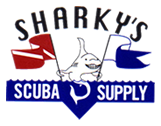Masks, Fins and Snorkels
Breaking in New Equipment
Maintenance Checklist
The obvious way to prevent corrosion in both aluminum and steel tanks is to prevent water from coming in contact with the tank metal for any length of time. The following recommendations will insure that water will not have a chance to damage your tank.
Inspect for nicks, cracks or chips in the lens of the mask. Never dive with a chipped or cracked lens. If you have prescription lens in your mask, ask for the plain glass lens that was taken out to put the prescription lens in.
Lens Retaining Ring
Inspect for any defects such as cracks, broken spot welds, stripped screws, or loose nuts that will affect the security of the retaining ring.
Purge Valve
If your mask has a purge valve, check it for any signs of leakage or deterioration, making sure the valve operates freely. With the mask held securely to your face, you should be able to force air out the purge valve by exhaling. Then inhale to check that the purge valve seals properly. No air should enter the mask through the purge valve.
Straps
Check the mask and fin straps for any signs of deterioration or distortion of the rubber. Flex the rubber gently when dry and look for signs of cracking and brittleness which will be most noticeable where the straps bend around the buckles.
Snorkel
Check for any looseness or separation around the mouthpiece, checking to ensure that the mouthpiece has not been bitten through and is free of cracks. The swivel joints on many snorkels should be disassembled in order to remove any debris or sand particles. Scrub the area lightly with a toothbrush, then reassemble. For snorkels with purge valves, check for any warping or cracking of the valve, and make sure it has been rinsed free from any debris and particles that could clog it.
Attachment Buckles
Check the mask and fin strap attachment buckles or holder for any signs of distortion or cracking. Check any retaining screws or pins for security, and occasionally tighten when needed.
Fins
If your fins are constructed of a combination of neoprene and plastic, don’t forget to check for signs of deterioration in the neoprene foot pocket. While the newer plastic materials used in the fin blade may be impervious to deterioration, the neoprene foot pocket will deteriorate if not properly protected from harmful elements such as chlorine, ozone, or ultraviolet rays.
Mask Cleaning
After each use, rinse thoroughly in fresh, warm water (not hot) to remove chlorine, sand, or any encrusted salt particles that have accumulated on the lens of the mask or in the narrow recesses around the lens retaining ring. Occasionally wash in warm, soapy water, followed by a thorough rinsing to remove traces of the chlorine, perspiration salt or lotions that may collect on the rubber over a period of time through normal use.
Prior to Storage
Allow the equipment to dry thoroughly before storage, but do not expose it to sunlight or heat for an extended period of time. The new plastic materials being used for masks, fins and snorkels require more protection from heat (such as car trunks, direct sun, around swimming pools, etc.) as heat exposure can cause warping or distortions. For prolonged periods of storage, remove the straps from masks and fins to relieve the stress on the rubber. The rubber may be coated with silicone lubricant to prevent drying and cracking, but avoid spraying the lens of the mask with silicone or grease as this will prevent it from defogging properly when diving. Surgical grade silicone masks should not be stored or carried in the same bag as other black neoprene products, as they may change colour when exposed to black rubber.
Mask and Fin Straps
Pay special attention to your mask and fin strap holders and buckles by taking care to rinse out the sand and salt particles that may have become lodged in the holder assemblies. With the new style quick release strap holders, relaxing the tension on the straps after each dive will contribute to their longevity.
Many mask and fin strap holders, or buckles, have an exclusive design which requires straps that are available only from the manufacturer. Be sure to carry replacement straps that fit your particular fin or mask design.

